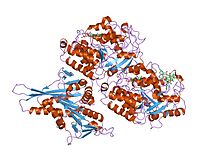
Back تيوبيولين Arabic Tubulinalar Azerbaijani টিউবুলিন Bengali/Bangla Tubulin BS Tubulina Catalan Tubulin Czech Tubulin Danish Tubuline German Tubulina Spanish توبولین Persian
| Tubulin | |||||||||
|---|---|---|---|---|---|---|---|---|---|
 kif1a head-microtubule complex structure in atp-form | |||||||||
| Identifiers | |||||||||
| Symbol | Tubulin | ||||||||
| Pfam | PF00091 | ||||||||
| Pfam clan | CL0442 | ||||||||
| InterPro | IPR003008 | ||||||||
| PROSITE | PDOC00201 | ||||||||
| SCOP2 | 1tub / SCOPe / SUPFAM | ||||||||
| |||||||||
Tubulin in molecular biology can refer either to the tubulin protein superfamily of globular proteins, or one of the member proteins of that superfamily. α- and β-tubulins polymerize into microtubules, a major component of the eukaryotic cytoskeleton.[1] It was discovered and named by Hideo Mōri in 1968.[2] Microtubules function in many essential cellular processes, including mitosis. Tubulin-binding drugs kill cancerous cells by inhibiting microtubule dynamics, which are required for DNA segregation and therefore cell division.
In eukaryotes, there are six members of the tubulin superfamily, although not all are present in all species.[3][4] Both α and β tubulins have a mass of around 50 kDa and are thus in a similar range compared to actin (with a mass of ~42 kDa). In contrast, tubulin polymers (microtubules) tend to be much bigger than actin filaments due to their cylindrical nature.
Tubulin was long thought to be specific to eukaryotes. More recently, however, several prokaryotic proteins have been shown to be related to tubulin.[5][6][7][8]
- ^ Gunning PW, Ghoshdastider U, Whitaker S, Popp D, Robinson RC (June 2015). "The evolution of compositionally and functionally distinct actin filaments". Journal of Cell Science. 128 (11): 2009–19. doi:10.1242/jcs.165563. PMID 25788699.
- ^ Mohri, H. (1968-03-16). "Amino-acid composition of "Tubulin" constituting microtubules of sperm flagella". Nature. 217 (5133): 1053–1054. doi:10.1038/2171053a0. ISSN 0028-0836. PMID 4296139.
- ^ Findeisen P, Mühlhausen S, Dempewolf S, Hertzog J, Zietlow A, Carlomagno T, Kollmar M "Six subgroups and extensive recent duplications characterize the evolution of the eukaryotic tubulin protein family" Genome Biol Evol (2014) 6:2274-2288.
- ^ Turk E, Wills AA, Kwon T, Sedzinski J, Wallingford JB, Stearns T "Zeta-Tubulin Is a Member of a Conserved Tubulin Module and Is a Component of the Centriolar Basal Foot in Multiciliated Cells" Current Biology (2015) 25:2177-2183.
- ^ Nogales E, Downing KH, Amos LA, Löwe J (June 1998). "Tubulin and FtsZ form a distinct family of GTPases". Nature Structural Biology. 5 (6): 451–8. doi:10.1038/nsb0698-451. PMID 9628483. S2CID 5945125.
- ^ Jenkins C, Samudrala R, Anderson I, Hedlund BP, Petroni G, Michailova N, et al. (December 2002). "Genes for the cytoskeletal protein tubulin in the bacterial genus Prosthecobacter". Proceedings of the National Academy of Sciences of the United States of America. 99 (26): 17049–54. Bibcode:2002PNAS...9917049J. doi:10.1073/pnas.012516899. PMC 139267. PMID 12486237.
- ^ Yutin N, Koonin EV (March 2012). "Archaeal origin of tubulin". Biology Direct. 7: 10. doi:10.1186/1745-6150-7-10. PMC 3349469. PMID 22458654.
- ^ Larsen RA, Cusumano C, Fujioka A, Lim-Fong G, Patterson P, Pogliano J (June 2007). "Treadmilling of a prokaryotic tubulin-like protein, TubZ, required for plasmid stability in Bacillus thuringiensis". Genes & Development. 21 (11): 1340–52. doi:10.1101/gad.1546107. PMC 1877747. PMID 17510284.